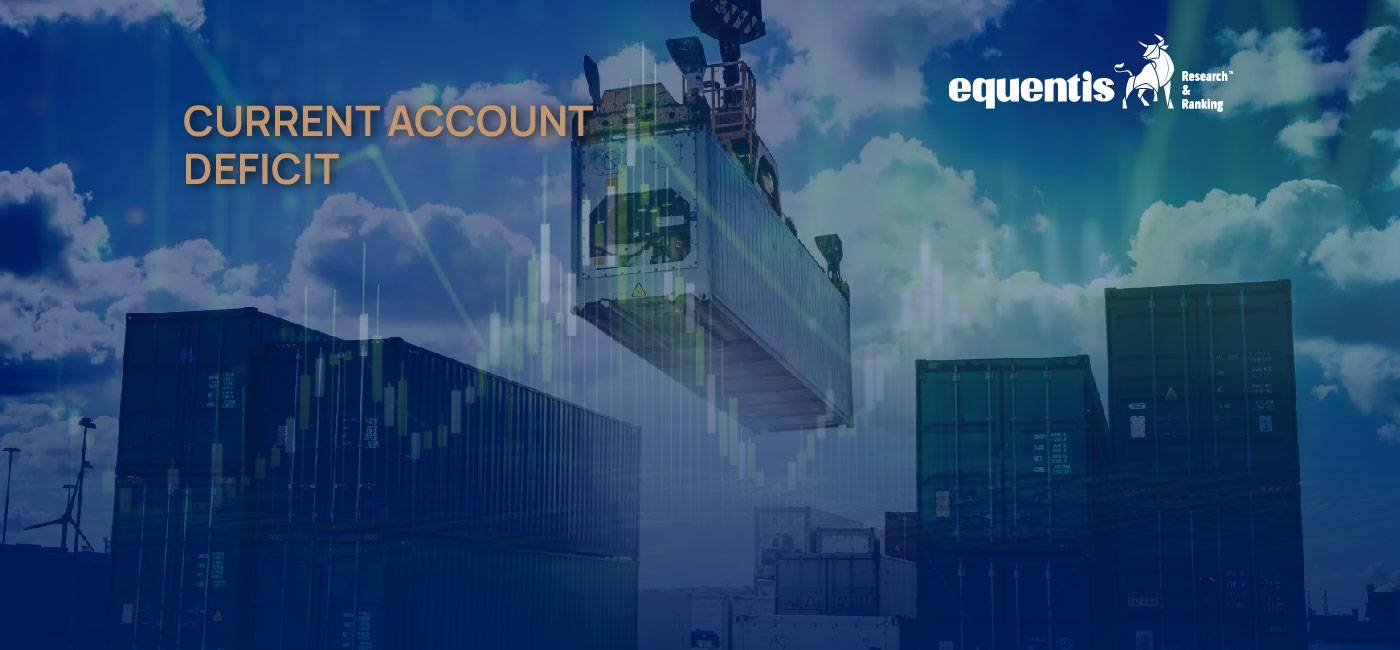The term “current account deficit” (CAD) is often used in economic discussions, and in India’s case, it’s a topic of frequent debate. A CAD simply means a country imports more goods and services than it exports. While a deficit can raise concerns about external imbalances, it’s not always negative for a developing economy like India. Let’s first understand what a current account is and why a CAD arises.
Understanding the Current Account
The current account is a part of a country’s balance of payments (BoP), which tracks all its economic transactions with the rest of the world. It’s divided into three main components:
- Merchandise Trade: It refers to the value of physical goods a country exports and imports.
- Services Trade: This includes income earned from tourism, IT, and financial services.
- Net Income from Abroad: This covers interest payments on foreign investments and worker remittances.
A CAD arises when the total value of imports (goods, services, and net income outflow) exceeds the total value of exports (goods, services, and net income inflow).
India recorded a current account surplus of $5.7 billion in the quarter ending March 2024. This is a significant shift from the $1.3 billion deficit in the previous quarter and marks the first surplus since June 2021. The surplus was mainly due to an increase in the services account surplus, which grew to $42.7 billion from 39.1 billion, driven by a 4.1% annual growth in services exports.
This means more money came into the country than went out, helping India limit its deficit in 2023-24 to $23 billion, or 0.7% of GDP.
This deficit is a seven-year low and the second-lowest in two decades, excluding the first pandemic year. India’s situation with the current account deficit (CAD) improved in 2023-24 due to several factors.
Factors For Falling Current Account Deficit
More Investments
There was a significant investment increase, likely due to higher government spending and a booming housing market. It could be because:
- The government spent more, creating opportunities for companies to supply materials and services for new projects (like building roads).
- The housing market boomed, leading to increased investment in construction and related services.
Savings on the Rise
This rise in investments happened alongside a jump in savings. Imagine a household saving more money – India’s savings rate went up. This could be because:
- People saved a larger portion of their income.
- Companies earned higher profits and reinvested some of them.
The current Account Deficit Shrinks
Despite the increased imports for investments, India’s CAD decreased. This is because the savings rate went up even more! Think of it as the increase in savings outweighed the extra spending on imports.
A higher savings rate allows India to invest more, even with a small CAD, which fuels economic growth. So, in this case, the CAD isn’t bad because it’s happening alongside solid savings and investment. It’s like using a credit card responsibly to invest in your future, not just for everyday expenses.
If India keeps a healthy savings rate (33%), even with a small deficit (borrowing 2%), it can still invest a lot (35%). This translates to ₹6 trillion available for building the nation’s future (infrastructure, education, etc.).
Deficits caused by high savings and increased investment can stimulate economic growth.
Let’s delve deeper into what a CAD signifies and explore how it can be beneficial under certain circumstances.
Potential Benefits of a Current Account Deficit for India
A moderate current account deficit can be a sign of a growing economy for several reasons:
- Financing Investment: A CAD allows India to access foreign capital. This capital can be used to finance crucial investments in infrastructure, technology, and other areas that boost long-term growth. Foreign direct investment (FDI) brings money, expertise, and technology, contributing to productivity gains.
- Competitive Imports: India’s current account deficit can indicate that it is importing essential goods for its development, like machinery and raw materials. These imports can help modernize industries, enhance production capabilities, and make Indian exports more competitive globally.
- Consumer Choice and Growth: A CAD allows consumers access to a wider variety of imported goods at potentially lower prices. This can stimulate domestic demand and economic growth.
- Currency Appreciation: A large inflow of foreign capital can strengthen the Indian rupee. However, a managed appreciation, where the rupee doesn’t become too strong, can make exports more competitive without hurting import-dependent industries.
The Importance of Management
For a CAD to be beneficial, it needs to be managed responsibly. Here’s why:
- Sustainability: A large and persistent CAD can pressure the rupee’s value and lead to external vulnerabilities. India must ensure the CAD is financed by sustainable sources like FDI rather than short-term debt.
- Composition of Imports: The type of imports matters. Focusing on essential goods and capital equipment is preferable to luxury items or excessive gold imports, which strain foreign exchange reserves.
- Boosting Exports: A long-term strategy should focus on increasing exports to narrow the trade gap. This can be achieved by promoting manufacturing, improving product quality, and diversifying export markets.
India’s Young Population: A Potential Boon, But Challenges Remain
India has a lot of young people entering the workforce – a good thing in theory! This means more people working, which could lead to:
- Higher Production: More workers can produce more goods and services.
- Increased Income: With more people working, overall national income could rise.
- More Savings: Ideally, with more income, people would also save more money.
The Bonus: Women in the Workforce: As families have fewer children, more women are joining the workforce, adding another layer of growth potential. This is called the “demographic dividend.”
The Challenge: Making it Work
Unfortunately, India hasn’t been able to capitalize on this opportunity entirely. Here’s why:
- Not Enough Jobs: There aren’t enough good jobs for all the young people entering the workforce.
- Skills Gap: Many workers don’t have the necessary skills for the available jobs.
- Economic Setbacks: Events like demonetization and the pandemic hurt the economy, making saving harder for people.
The Result: A Funding Gap
Because of these challenges, India might be unable to save enough money to invest in things that could further boost the economy, like infrastructure and education. This could lead to a current account deficit, which means India would need to borrow money from other countries.
India’s Foreign Exchange Outlook
Here’s a breakdown of what’s happening with foreign exchange:
- India’s government bonds are now included in some essential investment lists, which means more foreign investors are likely to buy them, bringing in more dollars.
- India’s economy is growing fast, and with elections settled, businesses that were waiting might now invest in India, bringing in more foreign money.
- If the US lowers interest rates, it could lead to more investment flowing into emerging markets like India.
The Challenge: Balancing the Flow
The Indian rupee has already strengthened a bit because of these positive factors. However, there are some things to keep in mind:
- If the rupee gets too solid, Indian exports become more expensive and less competitive in the global market.
- A current account deficit (borrowing from other countries) could help balance the inflow of foreign money and prevent the rupee from getting too strong too quickly.
Depreciation (in %) of the exchange rate against the US dollar in the first half of 2024
The Quality of Deficits and Surpluses Matters
Whether a country spends more or less than it earns (a deficit or surplus) isn’t always good or bad. What matters is why it’s happening.
Good vs. Bad Deficits
- Good Deficit: A good deficit is generally okay if a country borrows money to invest in things that will benefit the economy in the future (like building roads or schools).
- Bad Deficit: Borrowing money to buy things that don’t help the economy grow, like importing too much gold, is not good.
Good vs. Bad Surpluses
- Good Surplus: If a country saves money because it has many opportunities to invest within the country, that’s great.
- Bad Surplus: If a country saves money because there’s nowhere good to invest it at home, it’s not ideal.
Half of the top 20 emerging markets consistently face current account deficits. In contrast, the surplus countries are either oil-rich (such as Russia and Iran), export-driven (like China, Thailand, and Korea), or emerging export leaders (such as Vietnam).
Average Current Account Balance for Top 16 Emerging Market Economies between 2012 and 2023
A CAD isn’t inherently negative for a developing economy like India. It can be a source of investment, promote industrial growth, and offer consumers a more comprehensive range of goods. However, responsible management is crucial. Focusing on attracting FDI, boosting exports, and ensuring the import of essential goods are vital to reaping the benefits of CAD while mitigating potential risks. Following a balanced approach, India can leverage a moderate CAD to fuel its economic growth journey.
*Disclaimer Note: The securities quoted, if any, are for illustration only and are not recommendatory. This article is for education purposes only and shall not be considered as recommendation or investment advice by Research & Ranking. We will not be liable for any losses that may occur. Investment in securities market are subject to market risks. Read all the related documents carefully before investing. Registration granted by SEBI, membership of BASL, and certification from NISM in no way guarantee the performance of the intermediary or provide any assurance of returns to investors.
FAQs
What is a current account deficit (CAD)?
A current account deficit occurs when a country imports more goods, services, and capital than it exports. In simpler terms, the government spends more on foreign products and services than it earns from selling its products and services abroad.
Is a current account deficit always bad for India?
Not necessarily. A moderate CAD can sometimes be beneficial, mainly if used to fund productive infrastructure, technology, or education investments. However, a persistently high CAD can be problematic as it might lead to increased external debt and currency depreciation.
What are the leading causes of India’s current account deficit?
India’s CAD is primarily influenced by trade imbalance (importing more than exporting), higher oil prices, and gold imports. Income payments like dividends and interest on foreign investments can also contribute to the deficit.
How can India reduce its current account deficit?
India can address its CAD by boosting exports, promoting import substitution, attracting foreign investments, and controlling gold imports. Additionally, diversifying export markets and improving the economy’s efficiency can help reduce the deficit.
How useful was this post?
Click on a star to rate it!
Average rating 4.3 / 5. Vote count: 3
No votes so far! Be the first to rate this post.
I’m Archana R. Chettiar, an experienced content creator with
an affinity for writing on personal finance and other financial content. I
love to write on equity investing, retirement, managing money, and more.
























